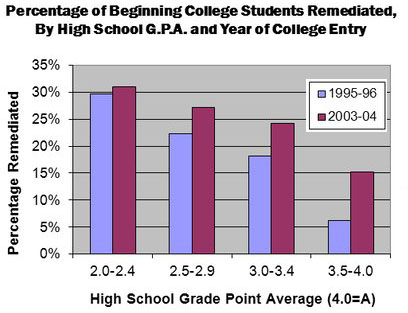Last year I read an interesting piece by Susan Headden in the Washington Monthly about college placement tests:
Most Americans think of the SAT as the ultimate high-stakes college admissions test, but the Accuplacer has more real claim to the title….When students apply to selective colleges, they’re evaluated based on high school transcripts, extracurricular pursuits, teacher recommendations, and other factors alongside their SAT scores. In open admissions colleges, placement tests typically trump everything else. If you bomb the SAT, the worst thing that can happen is you can’t go to the college of your choice. If you bomb the Accuplacer, you effectively can’t go to college at all.
My college days are long behind me, so I’d never heard of the Accuplacer. But apparently if you apply to a community college, you take it. It doesn’t matter if you’re a straight-A student. It doesn’t matter if you have half a dozen AP tests under your belt. It’s off to the Accuplacer lab for you.
This might not be such a terrible thing if the Accuplacer accurately identified kids who needed help to begin college-level work, and if remedial classwork did a good job of providing that help. But Judith  Scott-Clayton says today that neither of these things seems to be true:
Scott-Clayton says today that neither of these things seems to be true:
For students with high school grade-point averages between 3.5 and 4.0, remediation rates have more than doubled (see chart below). This is not a result of high school grade inflation — the percentage of students with G.P.A.’s in this range has not changed — but is consistent with increasingly ubiquitous placement testing.
Screening seemingly prepared students for remediation is questionable for at least two reasons. First, the benefits of remediation are far from obvious: remediation has been referred to as the Bermuda Triangle of postsecondary education, because the majority of those who enter never make it out. Across several rigorous, quasi-experimental studies of the causal impact of remediation, only one found positive effects on college outcomes, while others found null to negative effects.
Second, the tests commonly used to screen for college readiness are only weakly related to college outcomes, as two recent studies by the Community College Research Center show….My own research, using data from a large urban community college system with particularly high remediation rates, estimates that one in four students assigned to math remediation could have passed a college-level math course with a grade of B or better and one in three students assigned to English remediation could have passed freshman composition with a B or better.
If all this is true, it suggests that these placement tests are a waste of time. You can’t base high-stakes admissions decisions on them because they’re too inaccurate for that, so instead they’re used to place students in remedial classes. But that doesn’t do much good either. The ones who couldn’t handle college-level classes in the first place don’t improve much and just end up dropping out. So instead, why not let everyone into freshman classes and just see how they do?
I suppose that might strain class capacity, but at the very least, it sure sounds as if there ought to be a GPA cutoff for these things. If students volunteer for remedial classes, or if they do poorly in their first semester, let ’em take the classes. But if they have a decent GPA, why not let them at least give college a try before sending them off to the Bermuda Triangle?


















